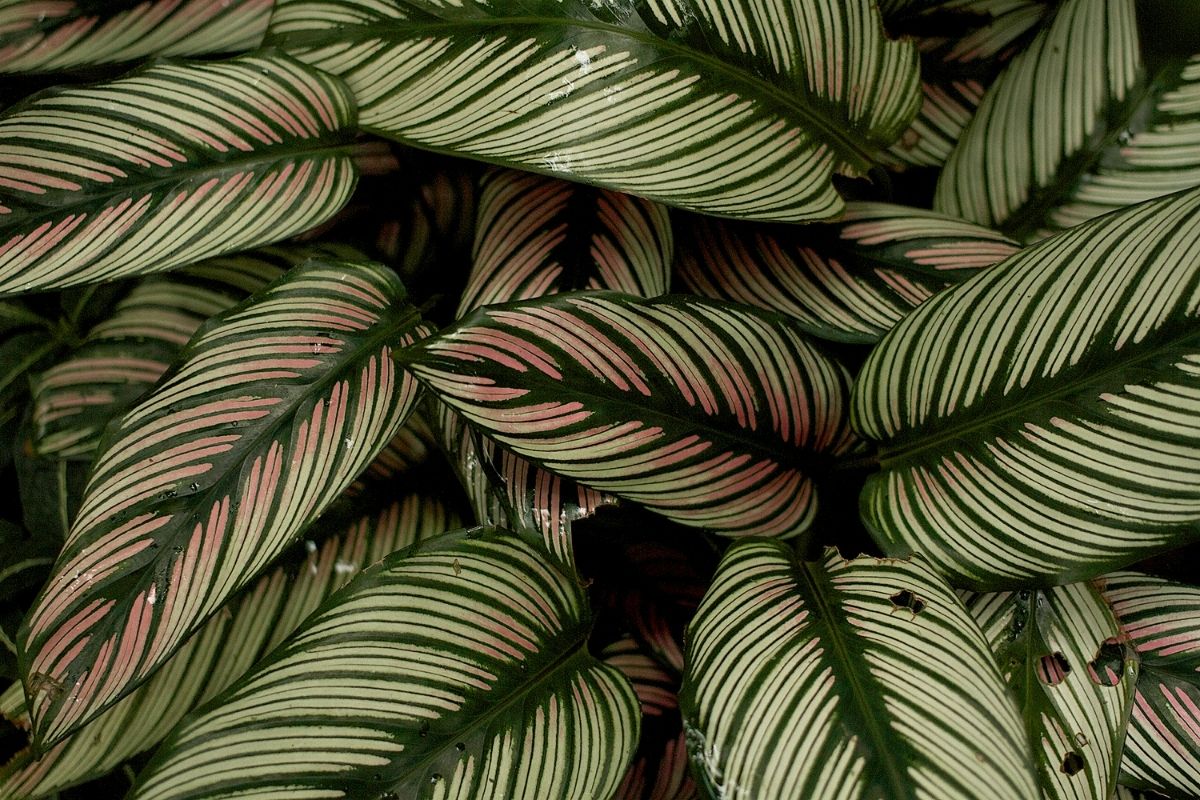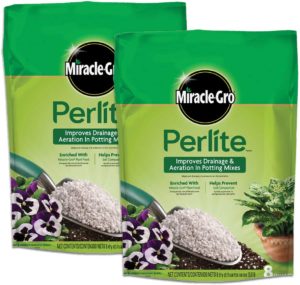If you’re living in an urban area, finding the perfect indoor plant can be quite frustrating. Many of the beautiful plants we love have a difficult time growing indoors, as they need direct sunlight or high humidity. Both of these can be hard to accommodate when you’re in an apartment.
That’s where calathea plants come in. And boy are there many calathea problems that come with them.
Calathea plants, commonly known as prayer plants, are a tropical plant family that does very well indoors. These plants come in a number of different variations, some with dark green leaves with a velvety texture, others with geometric patterns and gorgeous undersides.
They are a low-light plant, meaning they won’t need much direct sunlight in your home. However, some varieties are considered to be delicate plants, requiring optimal care to prevent issues like curling leaves or color changes.
If you’re looking for a long term solution for any of the common issues that affect these tropical plants, keep reading. This article is going to help you pinpoint the issues you may face with your calathea plant.
Calathea leaves curling
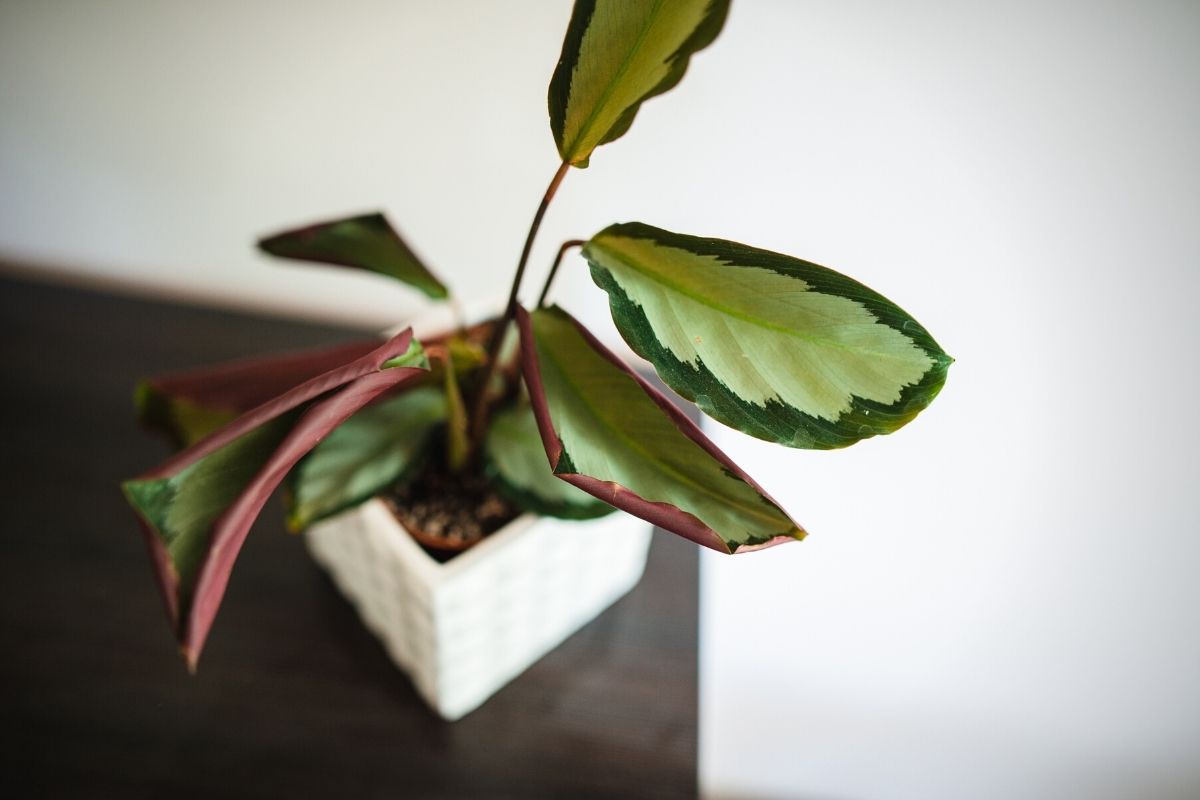
Calathea plants are tropical, meaning that they’re used to abundant soil moisture, as well as higher humidity levels. Calathea leaf curling is a sign that the plant isn’t receiving enough water. This can be a result of the Calathes’ soil being too dry, and in rare cases, due to low humidity.
In rarer cases still, curling Calathea leaves are a result of high temperatures, overwatering, disease, or too much fertilizer – even if the fertilizer is specially formulated for Calathea.
The most common cause of curling Calathea leaves, still, is a lack of water.
Scientifically, leaves curling is a defence mechanism. The plant aims to defend itself from further dehydration by reducing the transpiration rate. A reduced transpiration rate helps to fend off any further water loss. Larger surface areas are more prone to more transpiration, and the plant telling its leaves to curl reduces that surface area.
✨ How to fix it: Provide the plant with an abundance of distilled water, or filtered water. Water the plant until you see water leaking from the drainage hole(s) at the bottom of the pot.
After replenishing the water, follow a consistent watering schedule, providing water at least once a week, or whenever the top 2 inches of soil are noticeably dry. Try using a moisture meter in the future to check on soil moisture levels periodically.
Calathea leaves drooping
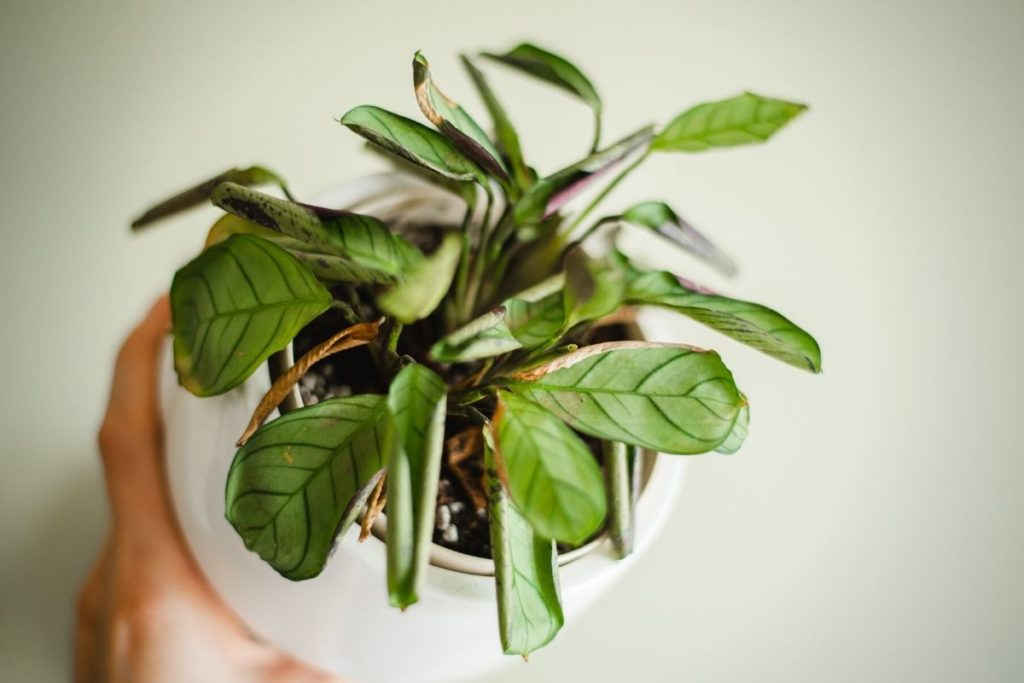
When you notice your calathea leaves curling, you may also notice that they’re drooping. Like curled calathea leaves, drooping leaves are often a sign of dehydration.
However, it can also be due to water quality, improper watering, low humidity, or damage to the roots. All of these cause disruption to the water supply that the plant receives.
When a plant lacks a sufficient amount of water, turgor pressure is lost in the plant’s cells. This pressure is required for the plant to remain standing up right, as well as for the entire leaf to be displayed.
Calathea plants thrive when they’re in the jungle due to the moisture in their soil, as well as in the humid environments they’re found in. This helps them to maintain their hydration, as well as pressure.
✨ How to fix it: Be sure to check your plant’s soil. Dry soil is going to be the number one cause of a drop in hydration, and therefore drooping leaves.
Follow the same care for when your calathea leaves curl, and consider adding a humidity tray to help with dry air.
Yellow calathea leaves
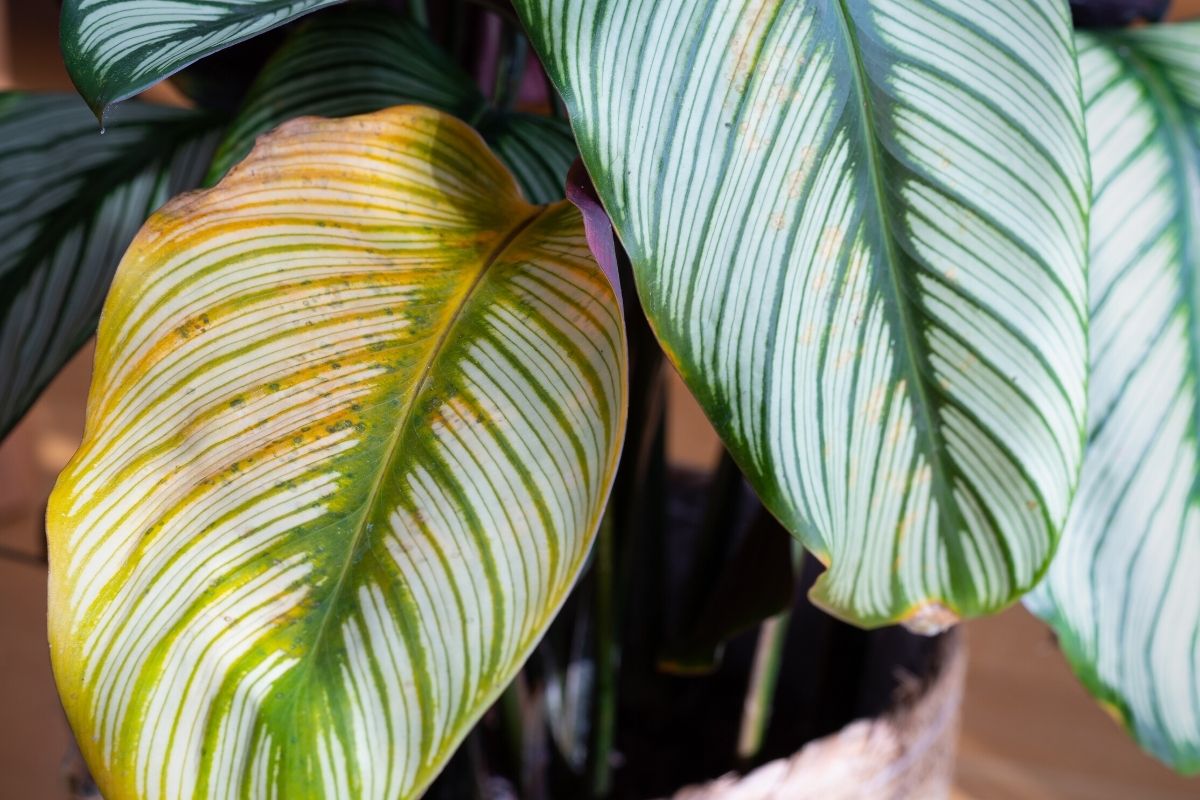
When you’re looking at a calathea, issues like speckled discoloration can be difficult to identify, depending on the variety you’re caring for. Often, it’s not until you see your calathea leaves curling, or entire leaves change color, that you know there’s a problem.
Yellow leaves, or leaves with brown tips, are a bit harder to diagnose than leaf curling in calathea plants.
When you consider the issues that may be affecting the coloration of your calathea plant, you have to consider the following issues:
- Improper watering
- Low humidity
- Pest infestation, like spider mites
- Heat stress, typically from colder temperatures
- Over-fertilization
- Disease
- Too much light
As you can see, discolored leaves are a bit more difficult to properly diagnose than calathea leaves curling. But why do they change color?
The only real explanation for the discoloration of leaves is the breakdown of plant cells. When you’re thinking about leaves changing color, you often think of trees dropping their leaves in the fall. This is because plants are breaking down and reabsorbing chlorophyll, a method of self preservation.
When plants do this, the other pigments in their leaves show through. The same thing is happening to your calathea plants, but for different reasons than the changing seasons.
✨ How to fix it: Because of the vast amount of causes behind yellow leaves, you first have to inspect your plant for accompanying causes. A spider mite infestation will be the easiest cause to identify, and can be taken care of by washing with insecticidal soap or oil.
It can be solved if you increase humidity, as well.
Following this, the plant’s environment and care concerning watering, direct sunlight, and heat stress have to be considered and addressed.
If all else fails, the calathea’s leaves that are yellowed should be trimmed, encouraging the plant to produce new, green leaves.
Read more: how to care for a rattlesnake plant
Calathea root rot
Root rot is a contributing factor to many different ailments a plant may face. It can be the reason that you find your calathea leaves curling, why the plant’s leaves are drooping, or why the leaves turn brown. Root rot needs to be diagnosed early if you plan on saving the plant.
That’s easier said than done, considering the issue is on a part of the plant that goes unseen, but it is possible to fix root rot if you catch it early.
Similar to yellowing leaves, rot in a calathea’s roots can be caused by a number of things. You may find that it’s related to any of these issues:
- Overwatering
- Poor drainage or filtration
- A pot that’s too large
- Fungal infections
- Too much fertilizer
- Low-quality water
Root rot is an issue that boils down to an anaerobic environment that allows for pathogen growth. When these pathogens grow, they damage root tissues, and make their way into the other parts of the leaves. This is why root rot is a cause of leaf curl, as well as drooping.
Rot occurs when a plant receives water that has pathogens already. If your tap water doesn’t have a filtration system in place to remove harmful microorganisms, then it can lead to accelerated rot. It can also occur when excess water builds in the pot, especially when the pot is too large.
The largest factor remains the water you’re using, though. Excessive exposure to standing water that carries plant pathogens will kill a plant quickly, causing it’s roots to rot.
✨ How to fix it: If your calathea plant has root rot, you’ll need to take a number of steps. First, it needs to be repotted in fresh soil, removing it from the anaerobic environment that’s killing the plant’s roots. Make sure an appropriate sized pot is used.
Then, begin watering with distilled water or bottled water (no tap water), reducing the exposure to harmful pathogens. Monitor the plant for high moisture levels, like curled leaves, drooping leaves, or yellowed leaves.

